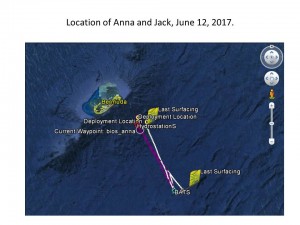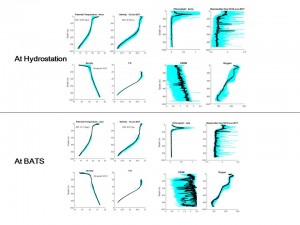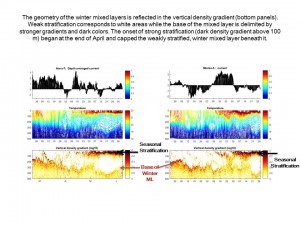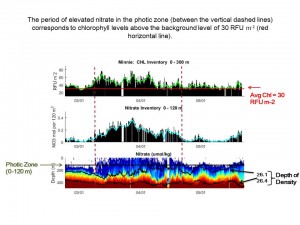This week Minnie and Jack are being rotated in and out of the water while Anna continues to hold station at Hydrostation S (HS) (Figure 1). Sea surface temperatures are 24.7ºC at HS and 23.2ºC, about a degree and one half cooler, at BATS. Pronounced deep chlorophyll maxima (DCM) are found between 80 and 100 meters at both locations.
Jack was temporarily recovered on May 13 as strong currents associated with the westward-moving anticyclonic eddy (see 22 April update) overpowered the glider’s ability to steer. He was re-deployed on May 29 at HS, was piloted to BATS where he remained until the planned recovery later this week as his battery runs low.
Anna and Minnie, both deployed on February 20, produced a remarkable record of this spring’s phytoplankton bloom (Figure 3). At HS, chlorophyll inventories showed sporadic and short-lived bursts rising above the average 30 RFU m-2 (red line) in March, culminating in a sharp peak near April 1, and falling below average values shortly thereafter. In contrast, chlorophyll inventories at BATS rose above 40 RFU m-2 in early March, remained high until the end of April, and dropped to average values (30 RFU m-2) after that. These differences in chlorophyll production reflected variation in the winter mixed layer depths measured at each location (Figure 4). At BATS, the bottom of the mixed layer reached below 300 m in March whereas the mixed layer depth at HS was closer to 200 m. The sharp, early-April chlorophyll peak corresponded to a brief deepening of the mixed layer at HS and stretching of subsurface isopycnals.
Nitrate inventories in the photic zone (0 – 120 meters) measured by Minnie’s SUNA sensor closely paralleled the chlorophyll inventories (Figure 5). Nitrate levels rose above zero between March 8 and May 2 corresponding to chlorophyll levels > 30 RFU m-2 and signifying injections of nitrate from deeper layers. The next step is to calibrate the chlorophyll and nitrate profiles to high precision measurements acquired during ship occupations of the time series sites, and to assess the molar ratio of chlorophyll carbon to nitrate concentrations measured by the gliders.
- Figure 1
- Figure 2
- Figure 3
- Figure 4
- Figure 5






